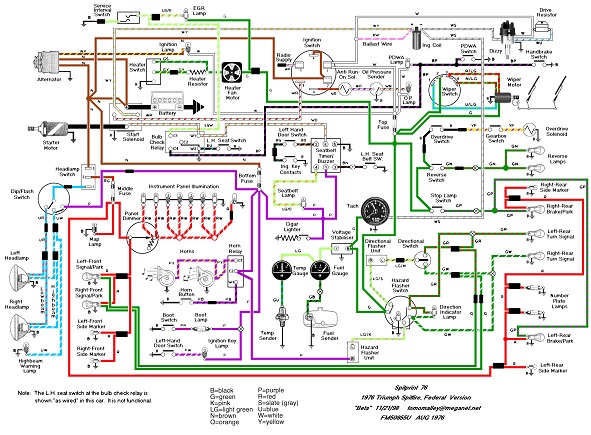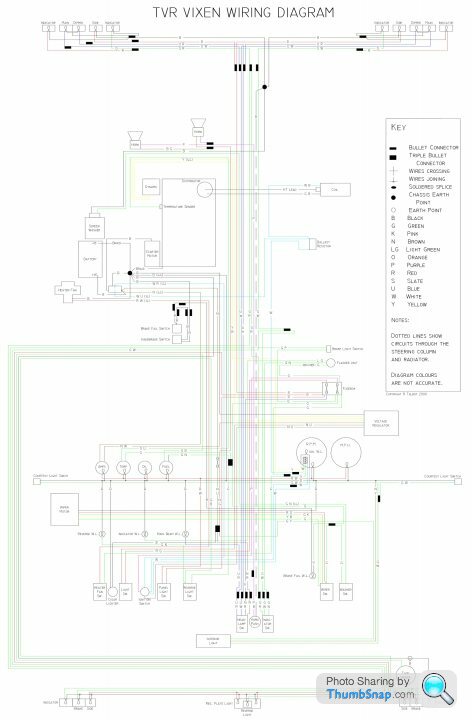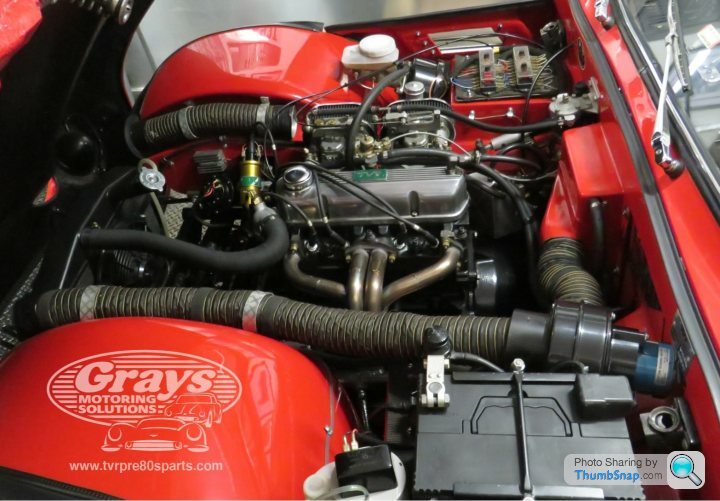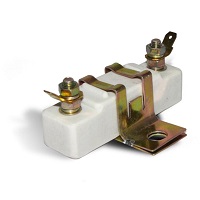Vixen S3 - Ballast Resister yes or no ?
Discussion
It is the operating voltage of the coil that decides if a ballast resistor is needed, a 12 Volt coil doesn't need a ballast resistor, a 9 Volt coil does need a ballast resistor
Take a look at the voltage of the coil that's fitted, if the coil is 12 Volt you will then have to make a decision, if your car needs to be original and from new it was fitted with a 9 Volt coil and ballast resistor you will need to obtain and fit the correct parts
Sorry I am unable to confirm if your car did originally have a ballast resistor circuit or not, someone with more knowledge will be along shortly
Take a look at the voltage of the coil that's fitted, if the coil is 12 Volt you will then have to make a decision, if your car needs to be original and from new it was fitted with a 9 Volt coil and ballast resistor you will need to obtain and fit the correct parts
Sorry I am unable to confirm if your car did originally have a ballast resistor circuit or not, someone with more knowledge will be along shortly
This may help. It's from the Burton Power web site
IGNITION COILS
BALLAST AND NON-BALLAST IGNITION SYSTEMS
Contact breaker (points) type ignition systems, as fitted to most Ford models up to around 1980 (although it lasted up to 1987 for the Capri), can have either a ballast fitted in the wiring loom or not.
WHAT IS A BALLAST?
Quite simply, it is a resistor that has the purpose of reducing the voltage to the coil.
WHY DO SOME IGNITION SYSTEMS HAVE A BALLAST FITTED WHERE OTHERS DO NOT?
Originally, all ignition systems did not have a ballast fitted which meant that the ignition system used a 12v coil with a 12v feed from the battery via the ignition switch. Such a system works fine when an engine is running, but problems can occur when starting the engine. The starter motor draws a huge current from the battery leaving less energy to create a spark across the spark plugs. The result is a weaker than normal spark which is not ideal for starting an engine. This problem is worsened by colder temperatures and/or a worn starter motor which will draw even more energy for starting and leave even less energy for sparking. To overcome such a problem, ignition systems were changed to run a lower voltage coil (usually 9v), and these coils could still give the same output as the original 12v coils. In order to run such a coil, the 12v ignition feed runs through a ballast, reducing it to 9v at the coil. To assist starting, a 12v feed (usually from the starter) bypasses the 9v ignition feed, giving the 9v coil a 12v feed. The result is a better than normal spark which is ideal for starting, particularly on cold damp mornings. As soon as the engine has started, the 12v feed is cut and the coil will run on the 9v ignition feed.
HOW DO I KNOW WHICH IGNITION SYSTEM IS FITTED?
Ballast ignition systems were introduced in around 1970. Virtually all Ford models from this date should have a ballast fitted. To find out for sure, use a multimeter to check the voltage on the positive wire of the coil with the ignition on. Around 9v means you have a ballast, around 12v means you don’t.
WHICH COIL SHOULD I USE WITH A BALLAST IGNITION SYSTEM?
Without modifying your ignition system, you can use any standard ballast coil or we offer performance ballast coils from Bosch (red coil 0221119030) or Intermotor (gold coil DLB110). Using a non-ballasted coil would mean that you are running a 12v coil on a 9v feed, resulting in a weak spark. You can however use such coils provided you remove the ballast resister.
WHICH COIL SHOULD I USE WITH A NON-BALLAST IGNITION SYSTEM?
Use any standard non-ballast coil, or we offer performance non-ballast coils from Bosch (blue coil 0221119027) or Intermotor (gold coil DLB105). Do not use a ballast coil. Although you may gain a performance advantage using such coils, failure will be imminent!
IGNITION COILS
BALLAST AND NON-BALLAST IGNITION SYSTEMS
Contact breaker (points) type ignition systems, as fitted to most Ford models up to around 1980 (although it lasted up to 1987 for the Capri), can have either a ballast fitted in the wiring loom or not.
WHAT IS A BALLAST?
Quite simply, it is a resistor that has the purpose of reducing the voltage to the coil.
WHY DO SOME IGNITION SYSTEMS HAVE A BALLAST FITTED WHERE OTHERS DO NOT?
Originally, all ignition systems did not have a ballast fitted which meant that the ignition system used a 12v coil with a 12v feed from the battery via the ignition switch. Such a system works fine when an engine is running, but problems can occur when starting the engine. The starter motor draws a huge current from the battery leaving less energy to create a spark across the spark plugs. The result is a weaker than normal spark which is not ideal for starting an engine. This problem is worsened by colder temperatures and/or a worn starter motor which will draw even more energy for starting and leave even less energy for sparking. To overcome such a problem, ignition systems were changed to run a lower voltage coil (usually 9v), and these coils could still give the same output as the original 12v coils. In order to run such a coil, the 12v ignition feed runs through a ballast, reducing it to 9v at the coil. To assist starting, a 12v feed (usually from the starter) bypasses the 9v ignition feed, giving the 9v coil a 12v feed. The result is a better than normal spark which is ideal for starting, particularly on cold damp mornings. As soon as the engine has started, the 12v feed is cut and the coil will run on the 9v ignition feed.
HOW DO I KNOW WHICH IGNITION SYSTEM IS FITTED?
Ballast ignition systems were introduced in around 1970. Virtually all Ford models from this date should have a ballast fitted. To find out for sure, use a multimeter to check the voltage on the positive wire of the coil with the ignition on. Around 9v means you have a ballast, around 12v means you don’t.
WHICH COIL SHOULD I USE WITH A BALLAST IGNITION SYSTEM?
Without modifying your ignition system, you can use any standard ballast coil or we offer performance ballast coils from Bosch (red coil 0221119030) or Intermotor (gold coil DLB110). Using a non-ballasted coil would mean that you are running a 12v coil on a 9v feed, resulting in a weak spark. You can however use such coils provided you remove the ballast resister.
WHICH COIL SHOULD I USE WITH A NON-BALLAST IGNITION SYSTEM?
Use any standard non-ballast coil, or we offer performance non-ballast coils from Bosch (blue coil 0221119027) or Intermotor (gold coil DLB105). Do not use a ballast coil. Although you may gain a performance advantage using such coils, failure will be imminent!
I certainly don't have anything like that in the engine bay. It could be mounted behind the dash but I can't see anything obvious.
I think I must be running a non-ballast system as that ties up with being 12v at the coil. It just seems odd that the earlier S2 owners book wiring diagram shows it having a ballasted coil.
Moto
I think I must be running a non-ballast system as that ties up with being 12v at the coil. It just seems odd that the earlier S2 owners book wiring diagram shows it having a ballasted coil.
Moto
nwarner said:
The ballast resistor on my Vixen S3 looks the same as the one philpot posted and is mounted on the inside of the drivers side wheel arch liner. A standard coil should have 3 ohms across the + and - terminals and a ballasted coil 1.5 ohms
Nige
Ours was in the same place. Fairly sure it was original fittmrnt as the car was only 6 year old when we bought it.Nige
Hi Andy.
No points, I'm running an Accuspark electronic ignition unit. I've determined that the car definitely does not have a ballasted coil system. Maybe someone changed it at some point or maybe cars leaving the factory that week were not ballasted because the ballast fitter was on a weeks holiday in Skegness. Who knows?
I've been trying to get my head around the wiring with a view to a complete rewire as my project for next winter. Electrics are not my strong point - well I'm fine with +ve, -ve, switches and even fuses but struggle with relays, solenoids & voltage regulators.
I'm booked into Maniflow next Tuesday for a new manifold & front pipe/box. Fingers crossed all goes OK. Early morning start as Dave wants me there for 8am to be sure it can be finished by end of day.
Cheers.
No points, I'm running an Accuspark electronic ignition unit. I've determined that the car definitely does not have a ballasted coil system. Maybe someone changed it at some point or maybe cars leaving the factory that week were not ballasted because the ballast fitter was on a weeks holiday in Skegness. Who knows?

I've been trying to get my head around the wiring with a view to a complete rewire as my project for next winter. Electrics are not my strong point - well I'm fine with +ve, -ve, switches and even fuses but struggle with relays, solenoids & voltage regulators.
I'm booked into Maniflow next Tuesday for a new manifold & front pipe/box. Fingers crossed all goes OK. Early morning start as Dave wants me there for 8am to be sure it can be finished by end of day.
Cheers.
Moto said:
but struggle with relays, solenoids & voltage regulators.
Relay and solenoid are basically the same thing, an electrically operated switch, used to take the load off a little switch on the dashboard for example.Shouldn't have a regulator unless you have a dynamo?
Something like this will give you a good basis to build on..................

Hi Mike,
Looks to be a really helpful diagram, but I can't read the text when printed as the definition is too low. Do you have a higher definition copy you could email to me?
Ref dynamo, yes still original so has a voltage regulator. I'm considering replacing it with a Dynator unit (alternator in a dynamo casing) which would then mean I can bypass the voltage regulator. Big money though at £360 compared to £100 for a new dynamo.
Moto.
Looks to be a really helpful diagram, but I can't read the text when printed as the definition is too low. Do you have a higher definition copy you could email to me?
Ref dynamo, yes still original so has a voltage regulator. I'm considering replacing it with a Dynator unit (alternator in a dynamo casing) which would then mean I can bypass the voltage regulator. Big money though at £360 compared to £100 for a new dynamo.
Moto.
Is this diagram of any use to you?
The problem is that older vehicles aren't wired to a very high standard hence they aren't fused correctly, you have a difficult decision to make before you get involved in re-wiring your Vixen, you can wire it as standard or make a custom wiring harness using relays and a several fused fuse-box. If you were to take the custom harness route you could include wiring for a mechanical control box and dynamo yet fit and wire an alternator, doing this would allow you to easily change back to the standard charging system for shows or if selling the Vixen
This diagram may or may not be of any use to you but this really doesn't matter as your Vixen will very likely be wired to British standard colour codes
If you were to list all the electrical components that your vixen has, it is a straight forward task to draw a diagram to match

Found here - http://www.tvr.at/grafiken/prwirdia.jpg
The problem is that older vehicles aren't wired to a very high standard hence they aren't fused correctly, you have a difficult decision to make before you get involved in re-wiring your Vixen, you can wire it as standard or make a custom wiring harness using relays and a several fused fuse-box. If you were to take the custom harness route you could include wiring for a mechanical control box and dynamo yet fit and wire an alternator, doing this would allow you to easily change back to the standard charging system for shows or if selling the Vixen
This diagram may or may not be of any use to you but this really doesn't matter as your Vixen will very likely be wired to British standard colour codes
If you were to list all the electrical components that your vixen has, it is a straight forward task to draw a diagram to match

Found here - http://www.tvr.at/grafiken/prwirdia.jpg
It was straight forward as I cheated.
I found a local guy (also a friend of a friend) who rewires vintage and classic cars for a living. He had the car for 9 days and rewired everything apart from the interior light (as I didn't want the headlining out after I'd done such a professional job fitting a new one). That was March 2019, and so far everything has been fine.
I decided not to stick to original wiring diagram but go with an improved design incorporating additional modern type fuse box, a dash located cut off for track work and switched to an alternator setup losing the regulator.
The wipers don't struggle anymore and the radio has almost no interference. The lights are brighter also. Almost like a modern car.
It wasn't cheap but worth the investment.
Moto
I found a local guy (also a friend of a friend) who rewires vintage and classic cars for a living. He had the car for 9 days and rewired everything apart from the interior light (as I didn't want the headlining out after I'd done such a professional job fitting a new one). That was March 2019, and so far everything has been fine.
I decided not to stick to original wiring diagram but go with an improved design incorporating additional modern type fuse box, a dash located cut off for track work and switched to an alternator setup losing the regulator.
The wipers don't struggle anymore and the radio has almost no interference. The lights are brighter also. Almost like a modern car.
It wasn't cheap but worth the investment.
Moto
Moto said:
It was straight forward as I cheated.
I found a local guy (also a friend of a friend) who rewires vintage and classic cars for a living. He had the car for 9 days and rewired everything apart from the interior light (as I didn't want the headlining out after I'd done such a professional job fitting a new one). That was March 2019, and so far everything has been fine.
I decided not to stick to original wiring diagram but go with an improved design incorporating additional modern type fuse box, a dash located cut off for track work and switched to an alternator setup losing the regulator.
The wipers don't struggle anymore and the radio has almost no interference. The lights are brighter also. Almost like a modern car.
It wasn't cheap but worth the investment.
Moto
Good call you wont regret it makes the car so much more user friendly if you never have to worry when you switch a switch will it work.I found a local guy (also a friend of a friend) who rewires vintage and classic cars for a living. He had the car for 9 days and rewired everything apart from the interior light (as I didn't want the headlining out after I'd done such a professional job fitting a new one). That was March 2019, and so far everything has been fine.
I decided not to stick to original wiring diagram but go with an improved design incorporating additional modern type fuse box, a dash located cut off for track work and switched to an alternator setup losing the regulator.
The wipers don't struggle anymore and the radio has almost no interference. The lights are brighter also. Almost like a modern car.
It wasn't cheap but worth the investment.
Moto
Hope they hid the fuse box better than mine still on the list of jobs on mine to make a cover to hide.
Andrew

Edited by Andrew Gray on Sunday 14th June 16:17
Gassing Station | TVR Classics | Top of Page | What's New | My Stuff




